A dummy pickup is a coil of wire that's wired with an existing hi-z magnetic single coil pickup. The dummy has no magnetics, it's not sensing the guitar/bass strings. It's job is to accept the electric signal created by the magnetic single coil pickup and flip it, which will remove a large portion of the 60 cycle humbuzz associated with single coil pickups. In the process, a very small amount of the treble signal is lost as well. However, this treble loss is far less than if the single coil magnetic pickup was turned into a "single coil footprint magnetic humbucking pickup" (a typical stacked or side-by-side "noiseless" Strat® or Tele® or JBass® magnetic pickup), where the complete magnetic single coil tone is totally lost as all the humbuzz is removed.
Dummy "pickups" (no, they're not pickups, they have no magnetics and can't sense the instrument strings) have been around for decades and were a staple design with the Alembic guitars of the 70's (a fave of Jerry Garcia), and is currently enjoying a renaissance with Suhr and other guitars. Even Stevie Ray Vaughn's Strats sported a dummy coil installed by his guitar tech, Rene. The dummy coil can be an "air coil", which is simply just a coil of wire. The larger the physical size of the coil, the less overall resistance is required to slice off the humbuzz. A dummy can also be a "ferrous coil", where the coil is wound around a non-magnetic iron core - think of a Strat® pickup with iron polepieces that aren't magnetic. For a normal magnetic single coil footprint sized dummy coil (Strat® , Tele® , Jbass® etc.), the coil resistance should be about 50% to about 80% of the real magnetic single coil to be used. For less resistance, I like to use one coil from a dual coil full size Gibson® humbucker or P-Bass® pickup, which will deliver 4k to 5k resistance.
Creating a viable dummy coil isn't rocket science and a quick and easy way is to use cheap, ceramic magnet powered Asian Strat® pickups. Remove the ceramic magnet from the bottom of the pickup by pulling off with a pair of hefty pliers - it will help to heat up the magnet with a hair dryer or heat gun to loosen the wax or contact cement used to hold it in place.
Most of these cheap ceramic magnetic pickups are wound on molded plastic bobbins, where the iron slug polepieces do not touch the coil wire, and will have a resistance between 5k and 6k. They can be used effectively as is when mated to a magnetic single coil pickup that has a somewhat higher resistance, 6k and up. The iron slugs can be left in as a "ferrous coil" for increased inductance or pushed out for an "air coil" with lowered inductance. Typically, leaving in the non-magnetic slugs will make for better noise cancelling. The leads on these pickups are almost always shielded. You can hook up the coil as is, with the magnet removed, and listen to the results. Or, you can experiment, remove the tape going around the coil, remove the shielded leads, and solder onto the fine hair-like coil wire a new set of leads. In the process, the outer coil wire can be unwound to lower the resistance of the coil - it helps to use a hair dryer (not a heat gun!) to soften the potting wax for easier unwinding of the coil wire. Use a multi-meter to check until you arrive at the desired resistance.
What matters most in hooking up a dummy coil is the wire winding direction of both the magnetic and dummy coils. A dummy can be hooked up in parallel to the magnetic pickup, where each coil has a lead wired to the output (a pickup switch input or the input lug on a volume pot) and the other lead wired to ground (typically the back of pot). My preferred hookup is to wire the magnetic in series with the dummy, where one lead of the magnetic goes to the switch or volume pot and the other lead goes to one lead of the dummy coil and the other dummy coil lead goes to ground. If a wire is added to where both coils are joined, and that wire is sent to a switch that has one side going to ground, the dummy coil can be switched in or out. This arrangement works well with a tone pot that has an attached push/pull dpdt switch.
Without knowing what is the start or finish lead of both coils (the magnetic or dummy), take a guess and make the series connection between the two coils. If the result is typical single coil humbuzz noise, flip the leads on the dummy coil. That's all there is to that. Not rocket science, indeed.
A Trem King Esquire with a Strat® dummy coil connected in series to a Cavalier Lion Tele bridge pickup. Yes, the dummy coil could have been placed inside the neck pickup cavity, for an easier and faster installation.
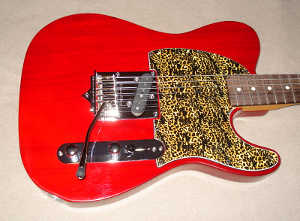
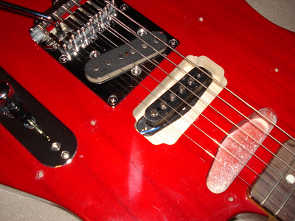
Wiring up the beast, using a p/p switch tone pot to kick the dummy in/out.

How to Add a Neck Pickup Volume Blender and Noise Cancelling Dummy Coil to Your Strat
If you have a typical 3 single coil strat (REAL single coils, not "noiseless"), with either a middle RWRP pup or "vintage wired" with all three pups of the same wind and polarity, a fairly simple set of wiring mods will give you increased functional versatility and lots less noise while still retaining that smoky sweet single coil tone we all love.
Caveats - You will need decent circuit soldering skills and the ability to read and understand the supplied wiring schematics.
the first mod - the neck pup blender.
This mod allows adding the neck pup to the bridge pup, for that nice "tele tone". start off by tweaking both "tone" pots, where the first pot will become a master no-load tone and the second becomes a no-load neck pickup blender pot - this allows adding the neck pickup to the bridge pickup for a very useful "tele tone". You can buy no-load pots, or convert any cts pot to no-load (jump
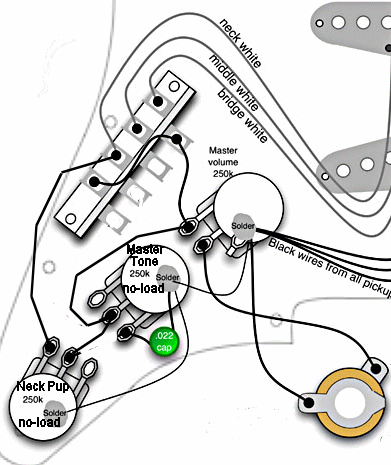
After performing the above mods, you'll have a more versatile strat, but if you have a strat with an RWRP middle pup there'll still be that nasty humbuzz in the 1,3,5 positions, and it'll also be there in the 1+5 tele tone position. And if your strat is real 50's old school with all three pups using the same top magnet polarity and coil direction wind, there's gonna be humbuzz everywhere.
I love true single coil tone and just won't give that up for any noiseless strat pup, so what to do? Dummy up yer strat! Yep, add a single non-magnetic ferrous slug coil between the pickup switch and the input on the volume pot.
WHOA! what's dat all about???
The second mod, adding a dummy noise cancelling coil to your strat
BUT FIRST, realize there is a HECKUVA lotta science (and black magic!) involved in "dummy coils" that are used in conjunction with single coil magnetic pickups. A LOT of effort and smarts are required to design and fine tune a dummy coil system that will kill a huge amount of humbuzz while almost not affecting single coil magnetic pickup tone at all. The following is a simplistic, hands-on approach that works - you will hear less humbuzz generated by single coil pickups, there might be a loss of high end, and the dummy coil used may not be the most optimally efficient at hum cancelling ... for that, you would need to do LOTS of tinkering and tweaking, after you get yer electronics degree. :)
For the dummy coil, I like using one of those cheap, asian ceramic strat pups - you know, the ceramic magnet pups that come with most low end squiers, sx, gfs, etc, guitars. hey're typically 5k to 7k in resistance and that'll work fine as a dummy coil with most any decent strat alnico single coil. These pups have underslung ceramic magnets that are stuck on with wax or glue. Pull off the mag with hefty pliers. Be sure to leave in the steel non-magnetized polepieces. Cut off the pickguard mounting holes from the pup's base - you want to make this coil as small as possible. The pup leads are either a single lead w/shield or a pair of wires. If shielded wire is part of the leads, just consider the shield as a separate single wire.
One dummy coil lead wire will go to the pickup selector switch and the other to the input lug of the volume pot - this is a series signal path wiring, not parallel.
Which lead goes where? Won't know 'til it's all together because for the very most part you'll not know what coil direction your good alnico pickups and the dummy coil were wound. The dummy coil must be wired as reverse wound to the real guitar magnetic single coil pickup. If you solder the dummy wire leads incorrectly and you'll create more humbuzz than without a dummy coil. You have a 50/50 chance of getting it right and you typically won't know right from wrong until the strat is together, strung up, and plugged in.
Before moving on, if we have a typical strat with an RWRP middle pup, we NEED to be able to switch the dummy coil in and out of the circuit - this will allow pickup switch positions 2 & 4 to function as they normally do, in parallel humbucking mode. You can use a simple micro SPST switch (radio shack) and drill a small 1/4" hole 'tween the the tone pots and mount it there. or use a push/pull 250k pot for the master tone pot (yes, this will not allow for the no-load tone pot feature). Wire the separate SPST switch or the pot's push/pull switch with one lug going to the the CRL pickup switch's last lug on the pickup side of the switch, and the other side of the switch to the input on the volume pot. When this switch is open, the dummy coil functions. When this switch is closed, the dummy coil is bypassed. Refer to the strat dummy coil circuit diagram below.
Before soldering in the dummy coil, and before the strat is reassembled, I solder separate wires from the switch and vol pot (same locations as the where the dummy coil leads are solder - refer to the strat dummy coil schematic) and sneak them outside from under the pickguard - put back the pickguard with just a few screws and allow those two wire leads to hang outside the pickguard (use only 3 screws or so to hold the pickguard in place), tune up to concert pitch, lay the strat down on a flat surface, face up. Connect the leads coming out of the strat to to the dummy coil leads by simply twisting them together - we don't know what is the correct order, so for now we're just guessing. Lay the dummy coil with its top facing up, same facing direction as the pups in your strat, because dummy coils are directionally sensitive.
Turn all the controls (pots) full up (clockwise), set the pup selector to only the bridge pup (#1 position), make sure your dummy coil on/off switch (either an SPST or tone pot push/pull) is set to "on", plug into an amp and listen. If the leads to the dummy coil are guessed correctly, there will be normal humbuzz when the SPST or p/p pot is in one position, and greatly reduced humbuzz in another position. If not, reverse the leads on the dummy coil and you should hear lots more quiet.
The strat dummy coil schematic ...
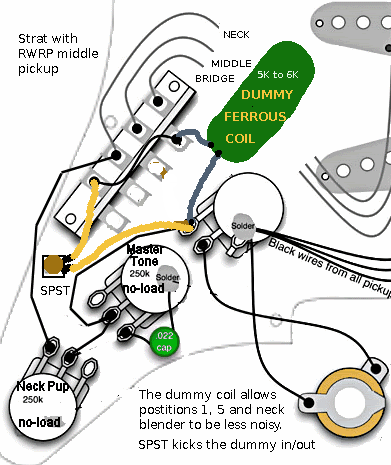
Once you have the correct dummy coil lead orientation, remove those "test leads" and solder the dummy coil to the pup switch and vol pot as shown in the schematic below. The dummy coil will typically nestle in nicely between the pup switch and the vol pot - I use a strip of double stick tap to anchor it to the pickguard ... but make SURE the dummy coil is properly oriented with regards to its top - dummy coils are directionally sensitive!
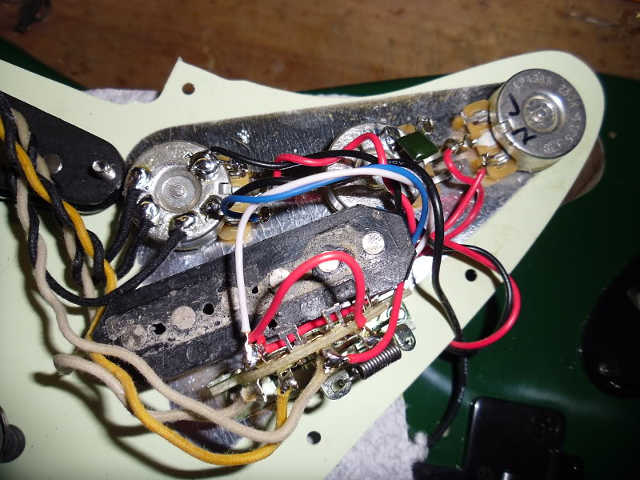
The resulting controls and features are ...
With the dummy coil activated, pickup positions 1 and 5, and 1+5 ("tele tone") will have reduced humbuzz with minor loss of treble. For positions 2 and 4, deactivate the dummy coil to allow the middle rwrp pup go into the normal parallel humbucking mode. Select switch position 3 (middle pup by itself) will always be noisy (sorry).
IF all three strat pups were charged with the exact same top magnetic polarity, and wound with the same directional coil wind, the dummy coil will work for all pickups, in all positions.
Addendum: Some folks like the way a dummy coil "fattens" up the tone by slicing off a tiny bit of the top end "icepick" treble of low wind pickups.
All of the above may seem way too wordy and complicated, making this project seem to be a difficult task, but in reality that's just not so.
Further Notes Concerning Dummy Coils ...
YES, there WILL be a loss of treble ('tone') as it gets sliced off with the humbuzz. particularly if one does no dummy testing of resistance, coil dimensions/footprint, coil location.
However, for all the dummy coils i've paired and tested with my own pups, the loss is minimal.
Does it change the tone? Yep.
There is a LOT of stuff to consider with hi-zdummy coils, and one could do LOTS of testing to seek the best marriage of noise reduction and 'tone'. but all that's not a rigid requirement.
The BEST dummy coil systems in passive guitars are lo-z, such as the Ilitch-Suhr system - not cheap, but the voices will be as close to natural single coil without significant humbuzz.